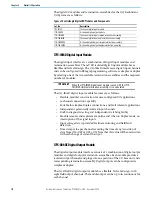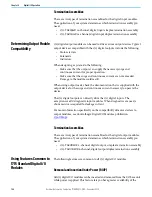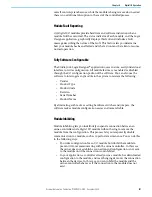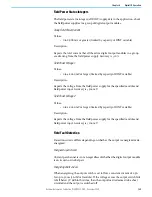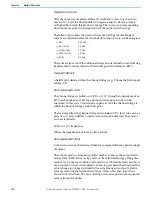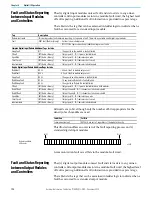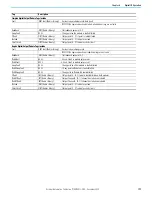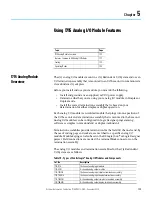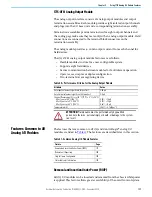
122
Rockwell Automation Publication 1715-UM001J-EN-P - December 2020
Chapter 4 Digital I/O Operation
These examples are instances where you can use module inhibiting:
•
You want to upgrade / replace digital I/O modules. This procedure is only
required when either changing / replacing a single simplex module or
when both duplex modules are removed before one is replaced. We
recommend that you do the following.
a. Inhibit the module.
b. Perform the upgrade (module change).
c. Uninhibit the module.
•
You are using a program that includes a module that is not physically
installed, but you do not want the controller to look for a module that
does not exist yet. In this case, you can inhibit the module in your
program until it physically resides in the proper slot.
Status Indicator Information
Each 1715 digital I/O module has a status indicator on the front of the module
that lets you check the module health and operational status of a module. The
status indicator displays vary for each module.
See Appendix A,
1715 Digital Input Module on page 286
, for detailed status
indicator information.
Features Specific to
1715-IB16D Digital Input
Modules
The features that are described in this section are available on 1715 digital input
modules.
Data Transfer on Either Cyclic Time or Change of State
Digital input modules always send data at the RPI, but they send data only at a
change of state if the COS feature is enabled. COS is more efficient than RPI
because it multicasts data only when a change occurs.
The table describes the two ways a module sends data to the owner-controller.
IMPORTANT
Whenever you inhibit an output module, it enters the Program
mode and all outputs change to the state configured for the
Program mode. For example, if an output module is configured so
that the state of the outputs goes to zero (0) during Program
mode, whenever that module is inhibited, the outputs go to zero
(0).
Topic
Description
Requested packet interval
A user-defined rate at which the module updates the
information sent to its owner-controller. This is also
known as Cyclic Data Transfer.
Change of state
Configurable feature that, when enabled, instructs
the module to update its owner-controller with new
data whenever a specified input point transitions
from On to Off and Off to On. The data is sent at the
RPI rate when there is no change of state. By default,
this setting is always enabled for input modules.
Содержание Allen-Bradley 1715-AENTR
Страница 10: ...10 Rockwell Automation Publication 1715 UM001J EN P December 2020 ...
Страница 114: ...114 Rockwell Automation Publication 1715 UM001J EN P December 2020 Chapter 2 Installation Instructions Notes ...
Страница 134: ...134 Rockwell Automation Publication 1715 UM001J EN P December 2020 Chapter 4 Digital I O Operation Notes ...
Страница 200: ...200 Rockwell Automation Publication 1715 UM001J EN P December 2020 Chapter 6 Configure the Redundant I O System Notes ...
Страница 244: ...244 Rockwell Automation Publication 1715 UM001J EN P December 2020 Chapter 9 Redundant I O System Diagnostics Notes ...
Страница 272: ...272 Rockwell Automation Publication 1715 UM001J EN P December 2020 Appendix C Reconfigure a Module Online Notes ...
Страница 290: ...290 Rockwell Automation Publication 1715 UM001J EN P December 2020 Appendix G History of Changes Notes ...
Страница 296: ...296 Rockwell Automation Publication 1715 UM001J EN P December 2020 ...
Страница 297: ...Rockwell Automation Publication 1715 UM001J EN P December 2020 297 Redundant I O System User Manual ...











